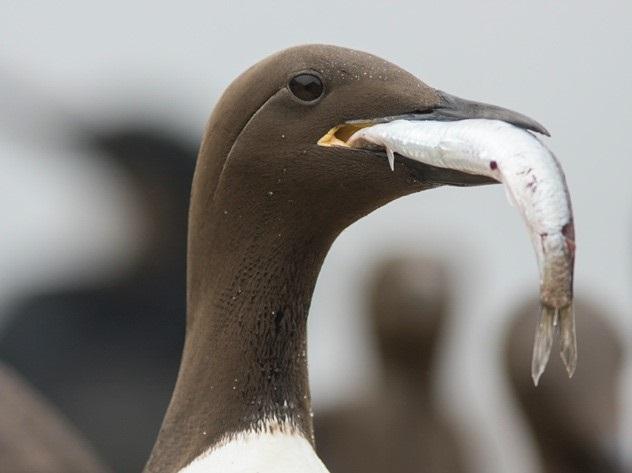Long-term data show fish-eating species are struggling to raise young in northern hemisphere

Credit: Ron LeValley
There is heightened public awareness that the world’s oceans are under duress, with over-fishing and plastic pollution as some of the more tangible problems. Now, seabirds are calling attention to another problem and have delivered a warning message.
Serving as translators of the birds’ message, an international team of 40 scientists led by William Sydeman at the Farallon Institute in northern California published findings on May 28 in the journal Science that some seabirds are struggling to raise young where the globe is most rapidly warming – in the northern hemisphere.
Using over 50 years of data from 67 seabird species across the globe, the team found that the breeding success of fish-eating seabirds in the north has trended downwards through time, meaning that they are producing fewer offspring each year.
“Seabirds can handle short-term declines in breeding success, but when breeding success becomes chronically poor – that’s not good,” says Sydeman. He explains that because seabirds rely on food like small fish and plankton (e.g., krill), long-term declines in their breeding success indicates that food resources aren’t holding up in ecosystems where the rate of ocean warming and other human impacts are highest.
Marine ecologists have often likened seabirds to “canaries in the coalmine” because of their sensitivity to environmental disturbances. This sensitivity is due to the challenge of raising young at dedicated sites on land (or on stationary ice) while their ocean-based food is constantly on the move.
Furthermore, seabirds need to consume roughly half of their body weight in this food daily, making them susceptible to reduced food availability due to climate or other factors.
Coauthor Marisol García-Reyes, an oceanographer at the Farallon Institute, explains that as climate warming alters ocean habitats, the locations of temperature zones in which various seabird food thrives can shift farther away from seabird breeding sites — and that’s when the birds suffer.
Indeed, less than a decade ago there was an estimated 1 million murres (a common seabird pictured above) that starved to death in the North Pacific due to an unprecedented marine heatwave that disrupted the food web.
According to Sydeman, while marine heatwaves may produce dramatic mortality events such as the murre die-off in the Northeast Pacific, long-term degradation of our marine ecosystems is a more insidious problem.
Sydeman emphasizes that the implications of the study extend well beyond seabirds. “What’s also at stake is the health of fish populations such as salmon and cod, as well as marine mammals and large invertebrates, such as squid, that are eating the same small forage fish and plankton that seabirds eat. When seabirds aren’t doing well, this is a red flag that something bigger is happening below the ocean’s surface which is concerning because we depend on healthy oceans for quality of life.”
On a more hopeful note, Sydeman points to their study’s results that seabirds in the north that forage on plankton have not suffered the same declines in breeding success as have those that feed on fish, and that breeding failures were less likely for birds that forage in deeper water. These patterns could signal resilience for some deeper-diving birds like puffins. Declining trends in seabird breeding success in the southern hemisphere have also not been so severe, but plankton-feeders show a declining trend.
Policies to alleviate climate change are obviously needed, a long-term solution brought forth in the paper. But the authors also suggest that in the north, where global warming may be worsened by additional human impacts like fishing, fisheries closures around breeding colonies during chick rearing periods will be needed to ease pressure.
In the south, where the rate of human-induced changes is picking up, creation of long-term Marine Protected Areas could prevent those birds from similar fates to their northern counterparts.
Sydeman and his team caution that there is a lot of variability in the data, and that more work is needed to understand why some species are doing better or worse than others. “We don’t understand all of the mechanisms at play here, as marine ecosystems are so complex and we often can’t observe key changes directly,” says Sydeman.
The authors stress the critical importance of maintaining long-term seabird monitoring programs, some of which may be canceled due to changing governmental funding allocations.
To coauthor Brian Hoover, of Chapman University, California, the collaboration among scientists was perhaps the most meaningful outcome of their study. “Scientists from all over came together to contribute their efforts to the bigger picture and that enabled us to discover global ecological trends that wouldn’t have been apparent from singular datasets – that’s inspiring and shows what we can accomplish working together.”
###
About Farallon Institute, California
Farallon Institute is a non-profit scientific organization dedicated to the understanding and preservation of healthy marine ecosystems. Its research is designed to provide the scientific basis for ecosystem-based management practices and policy reforms consistent with a productive marine world.
Farallon Institute emphasizes long-term, multi-species, multi-disciplinary research into the interdependent aspects of the marine environment, including the effects of natural and human based climate change, and the broad implications and influences of ocean currents, weather patterns, fishing practices and coastal development on marine food webs and ecosystem processes.
We are committed to an inclusive and equitable work environment, and strive to create diverse research teams to foster a marine scientific community that reflects the communities reliant upon the world’s oceans.
Media Contact
William Sydeman
[email protected]
Related Journal Article
http://dx.




